Green Aspects in Molecularly Imprinted Polymers by Biomass Waste Utilization
Abstract
:1. Introduction
1.1. The Value of Biomass Waste
1.2. Fundaments of MIPs
2. Different Biomass Waste in MIP Technology
2.1. Chitosan
2.2. Cellulose
2.3. Activated Carbon
2.4. Carbon Dots
2.5. Cyclodextrins
2.6. Biomass Waste Extracts in MIPs Preparation
2.7. Summary
3. Conclusions
Author Contributions
Funding
Institutional Review Board Statement
Informed Consent Statement
Conflicts of Interest
References
- Anastas, P.T.; Warner, J.C. Green Chemistry: Theory and Practice; Oxford University Press: New York, NY, USA, 1998. [Google Scholar]
- Anastas, P.; Eghbali, N. Green Chemistry: Principles and Practice. Chem. Soc. Rev. 2010, 39, 301–331. [Google Scholar] [CrossRef]
- Tang, S.; Bourne, R.; Smith, R.; Poliakoff, M. The 24 principles of green engineering and green chemistry: “IMPROVEMENTS PRODUCTIVELY”. Green Chem. 2008, 10, 268–269. [Google Scholar] [CrossRef]
- Sheldon, R.A. Fundamentals of green chemistry: Efficiency in reaction design. Chem. Soc. Rev. 2012, 41, 1437–1451. [Google Scholar] [CrossRef] [Green Version]
- Sheldon, R.A. Metrics of green chemistry and sustainability: Past, present, and future. ACS Sustain. Chem. Eng. 2018, 6, 32–48. [Google Scholar] [CrossRef] [Green Version]
- Garedew, M.; Lin, F.; Song, B.; DeWinter, T.M.; Jackson, J.E.; Saffron, C.M.; Lam, C.H.; Anastas, P.T. Greener routes to biomass waste valorization: Lignin transformation through electrocatalysis for renewable chemicals and fuels production. ChemSusChem 2020, 13, 4214–4237. [Google Scholar] [CrossRef]
- Shanks, B.H.; Keeling, P.L. Bioprivileged molecules: Creating value from biomass. Green Chem. 2017, 19, 3177–3185. [Google Scholar] [CrossRef]
- Cerda, A.; Artola, A.; Barrena, R.; Font, X.; Gea, T.; Sánchez, T. Innovative production of bioproducts from organic waste through solid-state fermentation. Front. Sustain. Food Syst. 2019, 3, 63. [Google Scholar] [CrossRef] [Green Version]
- Zuin, V.G.; Ramin, L.Z. Green and sustainable separation of natural products from agro-industrial waste: Challenges, potentialities, and perspectives on emerging approaches. Top Curr. Chem. 2018, 376, 3. [Google Scholar] [CrossRef] [PubMed] [Green Version]
- Jha, A.; Kumar, A. Biobased technologies for the efficient extraction of biopolymers from waste biomass. Bioprocess Biosyst. Eng. 2019, 42, 1893–1901. [Google Scholar] [CrossRef]
- Pistone, A.; Espro, C. Current trends on turning biomass wastes into carbon materials for electrochemical sensing and rechargeable battery applications. Curr. Opin. Green Sustain. Chem. 2020, 26, 100374. [Google Scholar] [CrossRef]
- Yahya, M.A.; Al-Qodah, Z.; Zanariah Ngah, C.W. Agricultural bio-waste materials as potential sustainable precursors used for activated carbon production: A review. Renew. Sustain. Energy Rev. 2015, 46, 218–235. [Google Scholar] [CrossRef]
- Kang, C.; Huang, Y.; Yang, H.; Yan, X.F.; Chen, Z.P. A review of carbon dots produced from biomass wastes. Nanomaterials 2020, 10, 2316. [Google Scholar] [CrossRef] [PubMed]
- Abbas, A.; Mariana, L.T.; Phan, A.N. Biomass-waste derived graphene quantum dots and their applications. Carbon 2018, 140, 77–99. [Google Scholar] [CrossRef] [Green Version]
- Vasapollo, G.; Del Sole, R.; Mergola, L.; Lazzoi, M.R.; Scardino, A.; Scorrano, S.; Mele, G. Molecularly imprinted polymers: Present and future perspective. Int. J. Mol. Sci. 2011, 12, 5908–5945. [Google Scholar] [CrossRef] [Green Version]
- Chen, L.; Wang, X.; Lu, W.; Wu, X.; Li, J. Molecular imprinting: Perspectives and applications. Chem. Soc. Rev. 2016, 45, 2137. [Google Scholar] [CrossRef] [PubMed]
- Culver, H.A.; Steichen, S.D.; Peppas, N.A. A Closer look at the impact of molecular imprinting on adsorption capacity and selectivity for protein templates. Biomacromolecules 2016, 17, 4045–4053. [Google Scholar] [CrossRef]
- Janczura, M.; Lulínski, P.; Sobiech, M. Imprinting technology for effective sorbent fabrication: Current state-of-art and future prospects. Materials 2021, 14, 1850. [Google Scholar] [CrossRef]
- Ansari, S. Combination of molecularly imprinted polymers and carbon nanomaterials as a versatile biosensing tool in sample analysis: Recent applications and challenges. TrAC Trends Anal. Chem. 2017, 93, 134–151. [Google Scholar] [CrossRef]
- Ansari, S.; Masoum, S. Recent advances and future trends on molecularly imprinted polymer-based fluorescence sensors with luminescent carbon dots. Talanta 2021, 223, 121411. [Google Scholar] [CrossRef] [PubMed]
- Ashley, J.; Shahbazi, M.-A.; Kant, K.; Chidambar, V.A.; Wolff, A.; Bang, D.D.; Sun, Y. Molecularly imprinted polymers for sample preparation and biosensing in food analysis: Progress and perspectives. Biosens. Bioelectron. 2017, 91, 606–615. [Google Scholar] [CrossRef] [Green Version]
- Ahmad, O.S.; Bedwell, T.S.; Esen, C.; Garcia-Cruz, A.; Piletsky, S.A. Molecularly imprinted polymers in electrochemical and optical sensors. Trends Biotechnol. 2019, 37, 294–309. [Google Scholar] [CrossRef]
- Luliński, P. Molecularly imprinted polymers based drug delivery devices: A way to application in modern pharmacotherapy. A review. Mater. Sci. Eng. C 2017, 76, 1344–1353. [Google Scholar] [CrossRef]
- Sharabi, D.; Paz, Y. Preferential photodegradation of contaminants by molecular imprinting on titanium dioxide. Appl. Catal. B Environ. 2010, 95, 169–178. [Google Scholar] [CrossRef]
- Cantarella, M.; Mauro, A.D.; Gulino, A.; Spitaleri, L.; Nicotra, G.; Privitera, V.; Impellizzeri, G. Selective photodegradation of paracetamol by molecularly imprinted ZnO nanonuts. Appl. Catal. B Environ. 2018, 238, 509–517. [Google Scholar] [CrossRef]
- Yu, J.; Zhang, C.; Yang, Y.; Su, T.; Yi, G.; Zhang, X. Facile synthesis of molecularly imprinted black TiO2-x/carbon dots nanocomposite and its recognizable photocatalytic performance under visible-light. Appl. Surf. Sci. 2021, 551, 149476. [Google Scholar] [CrossRef]
- Bonatti, A.F.; De Maria, C.; Vozzi, G. Molecular imprinting strategies for tissue engineering applications: A review. Polymers 2021, 13, 548. [Google Scholar] [CrossRef] [PubMed]
- Jablonský, M.; Majová, V.; Šima, J.; Hrobǒnová, K.; Lomenová, A. Involvement of deep eutectic solvents in extraction by molecularly imprinted polymers—A minireview. Crystals 2020, 10, 217. [Google Scholar] [CrossRef] [Green Version]
- Viveiros, R.; Rebocho, S.; Casimiro, T. Green strategies for molecularly imprinted polymer development. Polymers 2018, 10, 306. [Google Scholar] [CrossRef] [Green Version]
- Li, N.; Yang, H. Construction of natural polymeric imprinted materials and their applications in water treatment: A review. J. Hazard. Mater. 2021, 403, 123643. [Google Scholar] [CrossRef] [PubMed]
- Madikizela, L.M.; Tavengw, N.T.; Tutuc, H.; Chimukac, L. Green aspects in molecular imprinting technology: From design to environmental applications. Trends Environ. Anal. Chem. 2018, 17, 14–22. [Google Scholar] [CrossRef]
- Muxika, A.; Etxabide, A.; Uranga, J.; Guerrero, P.; de la Caba, K. Chitosan as a bioactive polymer: Processing, properties and applications. Int. J. Biol. Macromol. 2017, 105, 1358–1368. [Google Scholar] [CrossRef]
- Zhang, L.; Zeng, Y.; Cheng, Z. Removal of heavy metal ions using chitosan and modified chitosan: A review. J. Mol. Liq. 2016, 214, 175–191. [Google Scholar] [CrossRef]
- Ali, A.; Ahmed, S. A review on chitosan and its nanocomposites in drug delivery. Int. J. Biol. Macromol. 2018, 109, 273–286. [Google Scholar] [CrossRef]
- LogithKumar, R.; KeshavNarayan, A.; Dhivya, S.; Chawla, A.; Saravanan, S.; Selvamurugan, N. A review of chitosan and its derivatives in bone tissue engineering. Carbohydr. Polym. 2016, 151, 172–188. [Google Scholar] [CrossRef] [PubMed]
- Mujtaba, M.; Morsi, R.E.; Kerch, G.; Elsabee, M.Z.; Kaya, M.; Labidi, J.; Khawar, K.M. Current advancements in chitosan-based film production for food technology; A review. Int. J. Biol. Macromol. 2019, 121, 889–904. [Google Scholar] [CrossRef] [PubMed]
- Kurita, K. Chitin and chitosan: Functional biopolymers from Marine Crustaceans. Mar. Biotechnol. 2006, 8, 203–226. [Google Scholar] [CrossRef] [PubMed]
- Zargar, V.; Asghari, M.; Dashti, A. A review on chitin and chitosan polymers: Structure, chemistry, solubility, derivatives, and applications. ChemBioEng Rev. 2015, 2, 204–226. [Google Scholar] [CrossRef]
- Tianwei, T.; Xiaojing, H.; Weixia, D. Adsorption behaviour of metal ions on imprinted chitosan resin. J. Chem. Technol. Biotechnol. 2001, 76, 191–195. [Google Scholar] [CrossRef]
- Xu, L.; Huang, Y.; Zhu, Q.; Ye, C. Chitosan in molecularly-imprinted polymers: Current and future prospects. Int. J. Mol. Sci. 2015, 16, 18328–18347. [Google Scholar] [CrossRef]
- Zouaoui, F.; Bourouina-Bacha, S.; Bourouina, M.; Jaffrezic-Renault, N.; Zine, N.; Errachid, A. Electrochemical sensors based on molecularly imprinted chitosan: A review. Trends Analyt. Chem. 2020, 130, 115982. [Google Scholar] [CrossRef]
- Karrat, A.; Lamaoui, A.; Amine, A.; Palacios-Santander, J.M.; Cubillana-Aguilera, L. Applications of chitosan in molecularly and ion imprinted polymers. Chem. Afr. 2020, 3, 513–533. [Google Scholar] [CrossRef]
- Di Bello, M.P.; Mergola, L.; Scorrano, S.; Del Sole, R. Towards a new strategy of a chitosan-based molecularly imprinted membrane for removal of 4-nitrophenol in real water samples. Polym. Int. 2017, 66, 1055–1063. [Google Scholar] [CrossRef]
- Di Bello, M.P.; Lazzoi, M.R.; Mele, G.; Scorrano, S.; Mergola, L.; Del Sole, R. A new ion-imprinted chitosan-based membrane with an azo-derivative ligand for the efficient removal of Pd(II). Materials 2017, 10, 1133. [Google Scholar] [CrossRef] [PubMed] [Green Version]
- Yu, Q.; Deng, S.; Yu, G. Selective removal of perfluorooctane sulfonate from aqueous solution using chitosan-based molecularly imprinted polymer adsorbents. Water Res. 2008, 3089–3097. [Google Scholar] [CrossRef] [PubMed]
- Cheng, Y.; Xu, K.; Li, H.; Li, Y.; Liang, B. Preparation of urea-imprinted cross-linked chitosan and its adsorption behavior. Anal. Lett. 2014, 47, 1063–1078. [Google Scholar] [CrossRef]
- Monier, M.; Abdel-Latif, D.A.; Abou El-Reash, J.G. Ion-imprinted modified chitosan resin for selective removal of Pd(II) ions. J. Colloid Interface Sci. 2016, 469, 344–354. [Google Scholar] [CrossRef]
- Bagheri, A.R.; Arabi, M.; Ghaedi, M.; Ostovan, A.; Wang, X.; Li, J.; Chen, L. Dummy molecularly imprinted polymers based on a green synthesis strategy for magnetic solid-phase extraction of acrylamide in food samples. Talanta 2019, 195, 390–400. [Google Scholar] [CrossRef] [PubMed]
- Bagheri, A.R.; Ghaedi, M. Green preparation of dual-template chitosan-based magnetic water-compatible molecularly imprinted biopolymer. Carbohydr. Polym. 2020, 236, 116102. [Google Scholar] [CrossRef] [PubMed]
- Barati, A.; Kazemi, E.; Dadfarnia, S.; Haji Shabani, A.M. Synthesis/characterization of molecular imprinted polymer based on magnetic chitosan/graphene oxide for selective separation/preconcentration of fluoxetine from environmental and biological samples. J. Ind. Eng. Chem. 2017, 46, 212–221. [Google Scholar] [CrossRef]
- Surya, S.G.; Khatoon, S.; Lahcen, A.A.; Nguyen, A.T.H.; Dzantiev, B.B.; Tarannum, N.; Salama, K.N. Chitosan gold nanoparticles molecularly imprinted polymer based ciprofloxacin sensor. RSC Adv. 2020, 10, 12823–12832. [Google Scholar] [CrossRef]
- Wang, L.; Li, J.; Wange, J.; Guo, X.; Wang, X.; Choo, J.; Chen, L. Green multi-functional monomer based ion imprinted polymers for selective removal of copper ions from aqueous solution. J. Colloid Interface Sci. 2019, 541, 376–386. [Google Scholar] [CrossRef] [PubMed]
- He, J.; Lu, Y.; Luo, G. Ca(II) imprinted chitosan microspheres: An effective and green adsorbent for the removal of Cu(II), Cd(II) and Pb(II) from aqueous solutions. Chem. Eng. J. 2014, 244, 202–208. [Google Scholar] [CrossRef]
- Zhu, Y.; Bai, Z.S.; Wang, H.L. Microfluidic synthesis of thiourea modified chitosan microsphere of high specific surface area for heavy metal wastewater treatment. Chin. Chem. Lett. 2017, 28, 633–641. [Google Scholar] [CrossRef]
- Kuthi, F.A.B.A.; Badri, K.H. Effect of cooking temperature on the crystallinity of acid hydrolysed-oil palm cellulose. In AIP Conference Proceedings 1614; American Institute of Physics: College Park, MD, USA, 2014; Volume 456. [Google Scholar] [CrossRef]
- Hu, Z.H.; Wang, Y.F.; Ahmed Mohamed Omer, A.M.; Ouyang, X.K. Fabrication of ofloxacin imprinted polymer on the surface of magnetic carboxylated cellulose nanocrystals for highly selective adsorption of fluoroquinolones from water. Int. J. Biol. Macromol. 2018, 107, 453–462. [Google Scholar] [CrossRef]
- Brinchi, L.; Cotana, F.; Fortunati, E.; Kenny, J.M. Production of nanocrystalline cellulose from lignocellulosic biomass: Technology and applications. Carbohydr. Polym. 2013, 94, 154–169. [Google Scholar] [CrossRef] [PubMed]
- Godage, N.H.; Gionfriddo, E. Use of natural sorbents as alternative and green extractive materials: A critical review. Anal. Chim. Acta 2020, 1125, 187–200. [Google Scholar] [CrossRef] [PubMed]
- Nakai, Y.; Yoshikawa, M. Cellulose as a membrane material for optical resolution. Polym. J. 2015, 47, 334–339. [Google Scholar] [CrossRef]
- Ullah, H.; Wahid, F.; Santos, H.A.; Khan, T. Advances in biomedical and pharmaceutical applications of functional bacterial cellulose-based nanocomposites. Carbohydr. Polym. 2016, 150, 330–352. [Google Scholar] [CrossRef]
- Arca, H.C.; Mosquera-Giraldo, L.I.; Bi, V.; Xu, D.; Taylor, L.S.; Edgar, K.J. Pharmaceutical applications of cellulose ethers and cellulose ether esters. Biomacromolecules 2018, 19, 2351–2376. [Google Scholar] [CrossRef]
- Sun, B.; Zhang, M.; Shen, J.; He, Z.; Fatehi, P.; Nik, Y. Application of cellulose-based materials in sustained drug delivery systems. Curr. Med. Chem. 2019, 26, 2485–2501. [Google Scholar] [CrossRef]
- Andriani, D.; Apriyana, A.Y.; Karina, M. The optimization of bacterial cellulose production and its applications: A review. Cellulose 2020, 27, 6747–6766. [Google Scholar] [CrossRef]
- Lou, Z.; Wen, S.; Wan, L.; Zhang, P.; Wang, Y.; Zhang, F.; Xiong, Y.; Fan, Y. High-performance waste cellulose based adsorbent used for determination of Ag(I) coordination anions. J. Polym. Environ. 2018, 26, 2650–2659. [Google Scholar] [CrossRef]
- Shamsayei, M.; Yamini, Y.; Asiabi, H. Evaluation of highly efficient on-line yarn-in-tube solid phase extraction method for ultra-trace determination of chlorophenols in honey samples. J. Chromatogr. A 2018, 1569, 70–78. [Google Scholar] [CrossRef]
- Liang, X.; Liu, S.; Zhu, R.; Xiao, L.; Yao, S. Highly sensitive analysis of polycyclic aromatic hydrocarbons in environmental water with porous cellulose/zeolitic imidazolate framework-8 composite microspheres as a novel adsorbent coupled with high-performance liquid chromatography. J. Sep. Sci. 2016, 39, 2806–2814. [Google Scholar] [CrossRef] [PubMed]
- Abujaber, F.; Zougagh, M.; Jodeh, S.; Ríos, A.; Bernardo, F.J.G.; Doimeadios, R.R.M. Magnetic cellulose nanoparticles coated with ionic liquid as a new material for the simple and fast monitoring of emerging pollutants in waters by magnetic solid phase extraction. Microchem. J. 2018, 137, 490–495. [Google Scholar] [CrossRef]
- Al-Maibd, R.; Al-Ashaq, W.; Zainuddin, N.; Ibrahim, N.A.; Samsudin, I.N.; Yahaya, N.; Kamaruzaman, S. Synthesis and optimization selective ion-imprinted polymer for the elimination of Ca II ions using Taguchi design. J. Polym. Res. 2021, 28, 84. [Google Scholar] [CrossRef]
- Derazshamishir, A.; Göktürk, I.; Tamahkar, E.; Yılmaz, F.; Sağlam, N. Phenol removal from wastewater by surface imprinted bacterial cellulose nanofibers. Environ. Technol. 2020, 41, 3134–3145. [Google Scholar] [CrossRef] [PubMed]
- Farenghi, A.R.; Moghadam, P.N.; Khalaf, J. Synthesis and characterization of a cellulose-based molecularly imprinted polymer in aqueous solution: The study of Furosemide slow release. Stärke 2017, 69, 1700002. [Google Scholar] [CrossRef]
- Fattahi, M.; Ezzatzadeh, E.; Jalilian, R.; Taheri, A. Micro solid phase extraction of cadmium and lead on a new ion-imprinted hierarchical mesoporous polymer via dual-template method in river water and fish muscles: Optimization by experimental design. J. Hazard. Mater. 2021, 403, 123716. [Google Scholar] [CrossRef]
- Jantarat, C.; Attakitmongkol, K.; Nichsapa, S.; Sirathanarun, P.; Srivaro, S. Molecularly imprinted bacterial cellulose for sustained-release delivery of quercetin. J. Biomater. Sci. Polym. Ed. 2020, 31, 1961–1976. [Google Scholar] [CrossRef] [PubMed]
- Lin, C.; Qiu, Y.; Fan, J.; Wang, M.; Ye, L.; Liu, Y.; Ye, X.; Huang, X.; Lv, Y.; Liu, M. Fabrication of photo-responsive cellulose based intelligent imprinted material and selective adsorption on typical pesticide residue. Chem. Eng. J. 2020, 394, 124841. [Google Scholar] [CrossRef]
- Piacham, T.; Isarankura-Na-Ayudhya, C.; Prachayasittikul, V. A simple method for creating molecularly imprinted polymer-coated bacterial cellulose nanofibers. Chem. Pap. 2014, 68, 838–841. [Google Scholar] [CrossRef]
- Sueyoshi, Y.; Fukushima, C.; Yoshikawa, C. Molecularly imprinted nanofiber membranes from cellulose acetate aimed for chiral separation. J. Membr. Sci. 2010, 357, 90–97. [Google Scholar] [CrossRef]
- Tamahkar, E.; Bakhshpour, M.; Denizli, A. Molecularly imprinted composite bacterial cellulose nanofibers for antibiotic release. Biomater. Sci. Polym. Ed. 2019, 30, 450–461. [Google Scholar] [CrossRef] [PubMed]
- Velempini, T.; Pillay, K.; Mbianda, X.Y.; Arotiba, O.A. Carboxymethyl cellulose thiol-imprinted polymers: Synthesis, characterization and selective Hg(II) adsorption. J. Environ. Sci. 2019, 79, 280–296. [Google Scholar] [CrossRef] [PubMed]
- Velempini, T.; Pillay, K.; Mbianda, X.Y.; Arotiba, O.A. Application of a polypyrrole/carboxy methyl cellulose ion imprinted polymer in the electrochemical detection of mercury in water. Electroanalysis 2018, 30, 2612–2619. [Google Scholar] [CrossRef]
- Wang, Y.F.; Wang, Y.G.; Ouyang, X.K. Surface-imprinted magnetic carboxylated cellulose nanocrystals for the highly selective extraction of six fluoroquinolones from egg samples. ACS Appl. Mater. Interfaces 2017, 9, 1759–1769. [Google Scholar] [CrossRef]
- Wang, P.; Zhang, A.; Jin, Y.; Zhang, Q.; Zhang, L.; Peng, Y.; Du, S. Molecularly imprinted layer-coated hollow polysaccharide microcapsules toward gate-controlled release of water-soluble drugs. RSC Adv. 2014, 4, 26063. [Google Scholar] [CrossRef]
- Wu, Y.; Xing, W.; Yan, J.; Cui, J.; Ma, F.; Gao, J.; Lu, J.; Yu, C.; Yan, M. Multilevel mineral-coated imprinted nanocomposite membranes for template-dependent recognition and separation: A well-designed strategy with PDA/CaCO3-based loading structure. J.Colloid Interface Sci. 2020, 575, 356–366. [Google Scholar] [CrossRef]
- Wu, Y.; Lin, R.; Ma, F.; Xing, W.; Pan, J. Three-dimensional macroporous wood-based selective separation membranes decorated with well-designed Nd(III)-imprinted domains: A high-efficiency recovery system for rare earth element. J. Colloid Interface Sci. 2021, 587, 703–714. [Google Scholar] [CrossRef]
- Zheng, X.; Zhang, Y.; Bian, T.; Zhang, Y.; Li, Z.; Pan, J. Oxidized carbon materials cooperative construct ionic imprinted cellulose nanocrystals films for efficient adsorption of Dy(III). Chem. Eng. J. 2020, 381, 122669. [Google Scholar] [CrossRef]
- Kenawy, I.M.; Ismail, M.A.; Hafez, M.A.H.; Hashem, M.A. Synthesis and characterization of novel ion-imprinted guanyl-modified cellulose for selective extraction of copper ions from geological and municipality sample. Int. J. Biol. Macromol. 2018, 115, 625–634. [Google Scholar] [CrossRef]
- Wang, J.; Wei, J.; Li, J. Straw-supported ion imprinted polymer sorbent prepared by surface imprinting technique combined with AGET ATRP for selective adsorption of La3+ ions. Chem. Eng. J. 2016, 293, 24–33. [Google Scholar] [CrossRef]
- Ioannidou, O.; Zabaniotou, A. Agricultural residues as precursors for activated carbon production—A review. Renew. Sustain. Energy Rev. 2007, 11, 1966–2005. [Google Scholar] [CrossRef]
- Dias, J.M.; Alvim-Ferraz, M.C.M.; Almeida, M.F.; Rivera-Utrilla, J.; Sánchez-Polo, M. Waste materials for activated carbon preparation and its use in aqueous-phase treatment: A review. J. Environ. Manag. 2007, 85, 833–846. [Google Scholar] [CrossRef]
- Danish, M.; Ahmad, T. A review on utilization of wood biomass as a sustainable precursor for activated carbon production and application. Renew. Sustain. Energy Rev. 2018, 87, 1–21. [Google Scholar] [CrossRef]
- Abioye, A.M.; Ani, F.N. Recent development in the production of activated carbon electrodes from agricultural waste biomass for supercapacitors: A review. Renew. Sustain. Energy Rev. 2015, 52, 1282–1293. [Google Scholar] [CrossRef]
- Tan, X.-F.; Liu, S.-B.; Liu, Y.-G.; Gu, Y.-L.-; Zeng, G.-M.; Hu, X.-J.; Wang, X.; Liu, S.-H.; Jiang, L.-H. Biochar a potential sustainable precursors for activated carbon production: Multiple applications in environmental protection and energy storage. Bioresour. Technol. 2017, 227, 359–372. [Google Scholar] [CrossRef]
- Zhang, S.; Yang, X.; Liu, L.; Ju, M.; Zheng, K. Adsorption behavior of selective recognition functionalized biochar to Cd(II) in wastewater. Materials 2018, 11, 299. [Google Scholar] [CrossRef] [Green Version]
- Su, W.; Wang, R.; Zhao, T. Co2-imprinted sustainable carbon derived from sunflower heads for highly effective capture of CO2 from flue gas. Aerosol Air Qual. Res. 2020, 20, 180–192. [Google Scholar] [CrossRef] [Green Version]
- Saputra, N.A.; Pari, G.; Darmawan, S.; Hendra, D.; Harsini, M. Syntesis and property of porous material for sustainable resources-based biosensor: A review. IOP Conf. Ser. Mater. Sci. Eng. 2020, 980, 012029. [Google Scholar] [CrossRef]
- Ding, Q.; Guo, Z.; Chen, W.; Yu, H.; Zhu, X.; Liu, Q.; Fu, M. Biomass activated carbon-derived imprinted polymer with multi-boronic acid sites for selective capture of glycoprotein. J. Colloid Interface Sci. 2021, 596, 225–232. [Google Scholar] [CrossRef]
- Sun, X.; Lei, Y. Fluorescent carbon dots and their sensing applications. Trends Anal. Chem. 2017, 89, 163–180. [Google Scholar] [CrossRef]
- Xu, X.Y.; Ray, R.; Gu, Y.L.; Ploehn, H.J.; Gearheart, L.; Raker, K.; Scrivens, W.A. Electrophoretic analysis and purification of fluorescent single-walled carbon nanotube fragments. J. Am. Chem. Soc. 2004, 126, 12736–12737. [Google Scholar] [CrossRef]
- Sun, Y.P.; Bing, Z.; Yi, L.; Wei, W.; Fernando, K.A.S.; Pathak, P.; Meziani, M.J.; Harru, B.A.; Xin, W.; Wang, H. Quantum-sized carbon dots for bright and colorful photoluminescence. J. Am. Chem. Soc. 2006, 128, 7756–7757. [Google Scholar] [CrossRef] [PubMed]
- Yang, T.; Huang, J.L.; Wang, Y.T.; Zheng, A.Q.; Shu, Y.; Wang, J.H. β-cyclodextrin-decorated carbon dots serve as nanocarriers for targeted drug delivery and controlled release. ChemNanoMat 2019, 5, 479–487. [Google Scholar] [CrossRef]
- Yu, H.J.; Shi, R.; Zhao, Y.F.; Waterhouse, J.I.N.; Wu, L.Z.; Tung, C.H.; Zhang, T.R. Smart utilization of carbon dots in semiconductor photocatalysis. Adv. Mater. 2016, 28, 9454–9477. [Google Scholar] [CrossRef] [PubMed]
- Zheng, J.X.; Liu, X.H.; Yang, Y.Z.; Liu, X.G.; Xu, B.S. Rapid and green synthesis of fluorescent carbon dots from starch for white light-emitting diodes. New Carbon Mater. 2018, 33, 276–288. [Google Scholar] [CrossRef]
- Hu, C.; Li, M.Y.; Qiu, J.S.; Sun, Y.P. Design and fabrication of carbon dots for energy conversion and storage. Chem. Soc. Rev. 2019, 48, 2315–2337. [Google Scholar] [CrossRef]
- Cheng, C.; Shi, Y.; Li, M.; Xing, M.; Wu, Q. Carbon quantum dots from carbonized walnut shells: Structural evolution, fluorescence characteristics, and intracellular bioimaging. Mater. Sci. Eng. C 2017, 79, 473–480. [Google Scholar] [CrossRef]
- Pandey, H.; Khare, P.; Singh, S.; Singh, S.P. Carbon nanomaterials integrated molecularly imprinted polymers for biological sample analysis: A critical review. Mater. Chem. Phys. 2020, 239, 121966. [Google Scholar] [CrossRef]
- Xiao, D.; Su, L.; Teng, Y.; Hao, J.; Bi, Y. Fluorescent nanomaterials combined with molecular imprinting polymer: Synthesis, analytical applications, and challenges. Microchim. Acta 2020, 187, 399. [Google Scholar] [CrossRef]
- Liu, H.; Ding, L.; Chen, L.; Chen, Y.; Zhou, T.; Li, H.; Xu, Y.; Zhao, L.; Huang, N. A facile, green synthesis of biomass carbon dots coupled with molecularly imprinted polymers for highly selective detection of oxytetracycline. J. Ind. Eng. Chem. 2019, 69, 455–463. [Google Scholar] [CrossRef]
- Shariati, R.; Rezaei, B.; Jamei, H.R.; Ensafi, A.A. Application of coated green source carbon dots with silica molecularly imprinted polymers as a fluorescence probe for selective and sensitive determination of phenobarbital. Talanta 2019, 194, 143–149. [Google Scholar] [CrossRef]
- Liu, H.; Ding, J.; Zhang, K.; Ding, L. Fabrication of carbon dots@restricted access molecularly imprinted polymers for selective detection of metronidazole in serum. Talanta 2020, 209, 120508. [Google Scholar] [CrossRef] [PubMed]
- Sun, X.; Liu, Y.; Niu, N.; Chen, L. Synthesis of molecularly imprinted fluorescent probe based on biomass-derived carbon quantum dots for detection of mesotrione. Anal. Bioanal. Chem. 2019, 411, 5519–5530. [Google Scholar] [CrossRef] [PubMed]
- Kazemifard, N.; Ensafi, A.A.; Rezaei, B. Green synthesized carbon dots embedded in silica molecularly imprinted polymers, characterization and application as a rapid and selective fluorimetric sensor for determination of thiabendazole in juices. Food Chem. 2020, 310, 125812. [Google Scholar] [CrossRef]
- Demir, B.; Lemberger, M.M.; Panagiotopoulou, M.; Medina Rangel, P.X.; Timur, S.; Hirsch, T.; Tse Sum Bui, B.; Wegener, J.; Haupt, K. Tracking hyaluronan: Molecularly imprinted polymer coated carbon dots for cancer cell targeting and imaging. ACS Appl. Mater. Interfaces 2018, 10, 3305–3313. [Google Scholar] [CrossRef] [PubMed]
- Rajput, K.N.; Patel, K.C.; Trivedi, U.B. β-cyclodextrin production by cyclodextrin glucanotransferase from an alkaliphile microbacterium terrae KNR 9 using different starch substrates. Biotechnol. Res. Int. 2016, 2016, 1–7. [Google Scholar] [CrossRef] [Green Version]
- Gentili, A. Cyclodextrin-based sorbents for solid phase extraction. J. Chromatogr. A 2020, 1609, 460654. [Google Scholar] [CrossRef]
- Szejtli, J. Past, present, and future of cyclodextrin research. Pure Appl. Chem. 2004, 76, 1825–1845. [Google Scholar] [CrossRef] [Green Version]
- Bruns, C.J. Exploring and exploiting the symmetry-breaking effect of cyclodextrins in mechanomolecules. Symmetry 2019, 11, 1249. [Google Scholar] [CrossRef] [Green Version]
- Lay, S.; Ni, X.; Yu, H.; Shen, S. State-of-the-art applications of cyclodextrins as functional monomers in molecular imprinting techniques: A review. J. Sep. Sci. 2016, 39, 2321–2331. [Google Scholar] [CrossRef] [PubMed]
- He, Y.; Zeng, S.; Abd El-Aty, A.M.; Hacımüftüǒglu, A.; Yohannes, W.K.; Khan, M.; She, Y. Development of water-compatible molecularly imprinted polymers based on functionalized β-cyclodextrin for controlled release of atropine. Polymers 2020, 12, 130. [Google Scholar] [CrossRef] [PubMed] [Green Version]
- Mamman, S.; Suah, F.B.M.; Raaov, M.; Mehamod, F.S.; Asman, S.; Zain, N.N.M. Removal of bisphenol A from aqueous media using a highly selective adsorbent of hybridization cyclodextrin with magnetic molecularly imprinted polymer. R. Soc. Open Sci. 2021, 8, 201604. [Google Scholar] [CrossRef] [PubMed]
- Zhao, X.; Wang, Y.; Zhang, P.; Lu, Z.; Xiao, Y. Recent advances of molecularly imprinted polymers based on cyclodextrin. Macromol. Rapid Commun. 2021, 42, 2100004. [Google Scholar] [CrossRef]
- Feng, G.; Ping, W.; Qin, X.X.; Liu, J.; Zhu, X. Ionic-liquid-loaded β-cyclodextrin-cross-linked polymer solid-phase extraction for the separation/analysis of linuron in fruit and vegetable samples. Food Anal. Methods 2015, 8, 2315–2320. [Google Scholar] [CrossRef]
- Farooq, S.; Nie, J.; Cheng, Y.; Bacha, S.A.S.; Chang, W. Selective extraction of fungicide carbendazim in fruits using β-cyclodextrin based molecularly imprinted polymers. J. Sep. Sci. 2020, 43, 1145–1153. [Google Scholar] [CrossRef]
- Chen, M.; Dong, Q.; Ni, W.; Zhao, X.; Gu, Q.; Tang, G.; Li, D.; Ma, W.; Hou, Z. Cyclodextrin-based polymer-assisted Ru nanoparticles for the aqueous hydrogenation of biomass-derived platform molecules. Chem. Select. 2017, 2, 10537–10545. [Google Scholar] [CrossRef]
- Dolai, J.; Ali, H.; Jana, N.R. Molecular imprinted poly-cyclodextrin for selective removal of dibutyl phthalate. ACS Appl. Polym. Mater. 2020, 2, 691–698. [Google Scholar] [CrossRef]
- Ma, J.-K.; Huang, X.-C.; Wei, S.-L. Preparation and application of chlorpyrifos molecularly imprinted solid-phase microextraction probes for the residual determination of organophosphorous pesticides in fresh and dry foods. J. Sep. Sci. 2018, 41, 3152–3162. [Google Scholar] [CrossRef]
- Guo, H.; Xiong, J.; Ma, W.; Wu, M.; Yan, L.; Li, K.; Liu, Y. Synthesis of molecularly imprinted polymers using acrylamide--cyclodextrin as a cofunctional monomer for the specific capture of tea saponins from the defatted cake extract of Camellia oleifera. J. Sep. Sci. 2016, 39, 4439–4448. [Google Scholar] [CrossRef]
- Tang, W.; Du, W.; Guo, P.; Wu, N.; Du, K.; Xu, C.; Luo, Z.; Chang, R.; Zeng, A.; Jing, W.; et al. Molecularly imprinted solid phase extraction using bismethacryloyl-β-cyclodextrin and methacrylic acid as double functional monomers for selective analysis of glycyrrhizic acid in aqueous media. J. Chromatogr. Sci. 2017, 55, 166–173. [Google Scholar] [CrossRef] [PubMed] [Green Version]
- Tan, L.; Li, Y.; Deng, F.; Pan, X.; Yu, H.; Marina, M.L.; Jiang, Z. Highly sensitive determination of amanita toxins in biological samples using β-cyclodextrin collaborated molecularly imprinted polymers coupled with ultra-high performance liquid chromatography tandem mass spectrometry. J. Chromatogr. A 2020, 1630, 461514. [Google Scholar] [CrossRef]
- Wang, C.; Cheng, L.; Zhang, L.; Zuo, Y. Graphene oxide based molecularly imprinted polymers modified with β-cyclodextrin for selective extraction of di(2-ethylhexyl) phthalate in environmental waters. J. Sep. Sci. 2019, 42, 1248–1256. [Google Scholar] [CrossRef] [PubMed]
- Sedghi, R.; Heidari, B.; Yassari, M. Novel molecularly imprinted polymer based on β-cyclodextrin@graphene oxide: Synthesis and application for selective diphenylamine determination. J. Colloid Interface Sci. 2017, 503, 47–56. [Google Scholar] [CrossRef] [PubMed]
- Zhu, F.; Li, L.; Xing, J. Selective adsorption behavior of Cd(II) ion imprinted polymers synthesized by microwave-assisted inverse emulsion polymerization: Adsorption performance and mechanism. J. Hazard. Mater. 2017, 321, 103–110. [Google Scholar] [CrossRef]
- Yu, T.; Xue, Z.; Zhao, X.; Chen, W.; Mu, T. Green synthesis of porous β-cyclodextrin polymers for rapid and efficient removal of organic pollutants and heavy metal ions from water. New J. Chem. 2018, 42, 16154–16161. [Google Scholar] [CrossRef]
- Liang, G.; Guo, X.; Tan, X.; Mai, S.; Chen, Z.; Zhai, H. Molecularly imprinted monolithic column based on functionalized β-cyclodextrin and multi-walled carbon nanotubes for selective recognition of benzimidazole residues in citrus samples. Microchem. J. 2019, 146, 1285. [Google Scholar] [CrossRef]
- Xu, Z.; Deng, P.; Li, J.; Xu, L.; Tang, S.; Zhang, F. Construction of imprint sites in mesopores of SBA-15 via thiol-ene click reaction. J. Mater. Sci. 2016, 51, 6295–6308. [Google Scholar] [CrossRef]
- Zhang, Y.; Li, J.; Wang, F.; Wu, G.; Qv, X.; Hong, H.; Liu, C. Recovery and separation of erythromycin from industrial wastewater by imprinted magnetic nanoparticles that exploit β-cyclodextrin as the functional monomer. J. Sep. Sci. 2016, 39, 450–459. [Google Scholar] [CrossRef]
- Shi, J.; Li, G.; Cui, Y.; Zhang, Y.; Liu, D.; Shi, Y.; He, H. Surface-imprinted β-cyclodextrin-functionalized carbon nitride nanosheets for fluorometric determination of sterigmatomycin. Microchim. Acta 2019, 186, 808–817. [Google Scholar] [CrossRef]
- Gao, J.W.; Xiong, H.W.; Zhang, W.; Wang, Y.; Wang, H.X.; Wen, W.; Zhang, X.H.; Wang, S.F. Electrochemiluminescent aptasensor based on beta-cyclodextrin/graphitic carbon nitride composite for highly selective and ultrasensitive assay of platelet derived growth factor BB. Carbon 2018, 130, 416–423. [Google Scholar] [CrossRef]
- Sardaremelli, S.; Hasanzadeh, M.; Razmi, H. Chemical binding of horseradish peroxidase enzyme with poly beta-cyclodextrin and its application as molecularly imprinted polymer for the monitoring of H2O2 in human plasma samples. J. Mol. Recognit. 2021, 34, e2884. [Google Scholar] [CrossRef] [PubMed]
- Tarannum, N.; Divya; Gautam, Y.K. Facile green synthesis and applications of sylver nanoparticles: A state-of-the-art review. RSC Adv. 2019, 9, 34926–34948. [Google Scholar] [CrossRef] [Green Version]
- Sharma, D.; Kanchi, S.; Bisetty, K. Biogenic synthesis of nanoparticles: A review. Arab. J. Chem. 2019, 12, 3576–3600. [Google Scholar] [CrossRef] [Green Version]
- Krishnaswamy, K.; Vali, H.; Orsat, V. Value-adding to grape waste: Green synthesis of gold nanoparticles. J. Food Eng. 2014, 142, 210–220. [Google Scholar] [CrossRef]
- Balalakshmi, C.; Gopinath, K.; Govindarajan, M.; Lokesh, R.; Arumugam, A.; Alharbi, N.S.; Kadaikunnan, S.; Khaled, J.M.; Benellif, G. Green synthesis of gold nanoparticles using a cheap Sphaeranthus indicus extract: Impact on plant cells and the aquatic crustacean Artemia nauplii. J. Photochem. Photobiol. B 2017, 173, 598–605. [Google Scholar] [CrossRef]
- Kaur, M.; Chopra, D. Green Synthesis of Iron Nanoparticles for Biomedical Applications. Glob. J. Nanomed. 2018, 4, 68–77. [Google Scholar]
- Skiba, M.; Vorobyova, V.; Pivovarov, O.; Shakun, A.; Gnatko, E.; Trus, I. Green synthesis of nanoparticles of precious metals: Antimicrobial and catalytic properties. East. Eur. J. Enterp. Technol. 2018, 5, 51–58. [Google Scholar] [CrossRef]
- Bastos-Arrieta, J.; Antonio Florido, A.; Pérez-Ràfols, C.; Serrano, N.; Fiol, N.; Poch, J.; Villaescusa, I. Green synthesis of Ag nanoparticles using grape stalk waste extract for the modification of screen-printed electrodes. Nanomaterials 2018, 8, 946. [Google Scholar] [CrossRef] [PubMed] [Green Version]
- Zia, M.; Gul, S.; Akhtar, J.; ul Haq, I.; Abbasi, B.H.; Hussain, A.; Naz, S.; Chaudhary, M.F. Green synthesis of silver nanoparticles from grape and tomato juices and evaluation of biological activities. IET Nanobiotechnol. 2017, 11, 193–199. [Google Scholar] [CrossRef] [PubMed]
- Kuppusamy, P.; Yusoff, M.M.; Maniam, G.P.; Govindan, N. Biosynthesis of metallic nanoparticles using plant derivatives and their new avenues in pharmacological applications—An updated report. Saudi. Pharm. J. 2016, 24, 473–484. [Google Scholar]
- Mittal, A.K.; Chisti, Y.; Banerjee, U.C. Synthesis of metallic nanoparticles using plant extracts. Biotechnol. Adv. 2013, 31, 346–356. [Google Scholar] [CrossRef]
- Hu, R.; Tang, R.; Xu, J.; Lu, F. Chemical nanosensors based on molecularly-imprinted polymers doped with silver nanoparticles for the rapid detection of caffeine in wastewater. Anal. Chim. Acta 2018, 1034, 176–183. [Google Scholar] [CrossRef]
- Yin, W.; Wu, L.; Ding, F.; Li, Q.; Wang, P.; Li, J.; Lu, Z.; Han, H. Surface-imprinted SiO2@Ag nanoparticles for the selective detection of BPA using surface enhanced Raman scattering. Sens. Actuators B 2018, 258, 566–573. [Google Scholar] [CrossRef]
- Matsui, J.; Akamatsu, K.; Nishiguchi, S.; Miyoshi, D.; Nawafune, H.; Tamaki, K.; Sugimoto, N. Composite of Au nanoparticles and molecularly imprinted polymer as a sensing material. Anal. Chem. 2004, 76, 1310–1315. [Google Scholar] [CrossRef]
- López, A.S.; Ramos, M.P.; Herrero, R.; Vilariño, J.M.L. Synthesis of magnetic green nanoparticle—Molecular imprinted polymers with emerging contaminants templates. J. Environ. Chem. Eng. 2020, 8, 103889. [Google Scholar] [CrossRef]
- Patra, S.; Ekta Roy, E.; Madhuri, R.; Sharma, P.K. Nanocomposite of bimetallic nanodendrite and reduced graphene oxide as a novel platform for molecular imprinting technology. Anal. Chim. Acta 2016, 918, 77–88. [Google Scholar] [CrossRef] [PubMed]
- Essawy, A.A. Silver imprinted zinc oxide nanoparticles: Green synthetic approach, characterization and efficient sunlight-induced photocatalytic water detoxification. J. Clean. Prod. 2018, 183, 1011–1020. [Google Scholar] [CrossRef]
- Le Goff, N.; Fomba, I.; Prost, E.; Merlier, F.; Haupt, K.; Duma, L.; Fayeulle, A.; Falcimaigne-Cordin, A. Renewable plant oil-based molecularly imprinted polymers as biopesticide delivery systems. ACS Sustain. Chem. Eng. 2020, 8, 15927–15935. [Google Scholar] [CrossRef]
- Khurana, L.; Balasubramanian, K. Adsorption potency of imprinted Starch/PVA polymers confined ionic liquid with molecular simulation framework. J. Environ. Chem. Eng. 2016, 4, 2147–2154. [Google Scholar] [CrossRef]
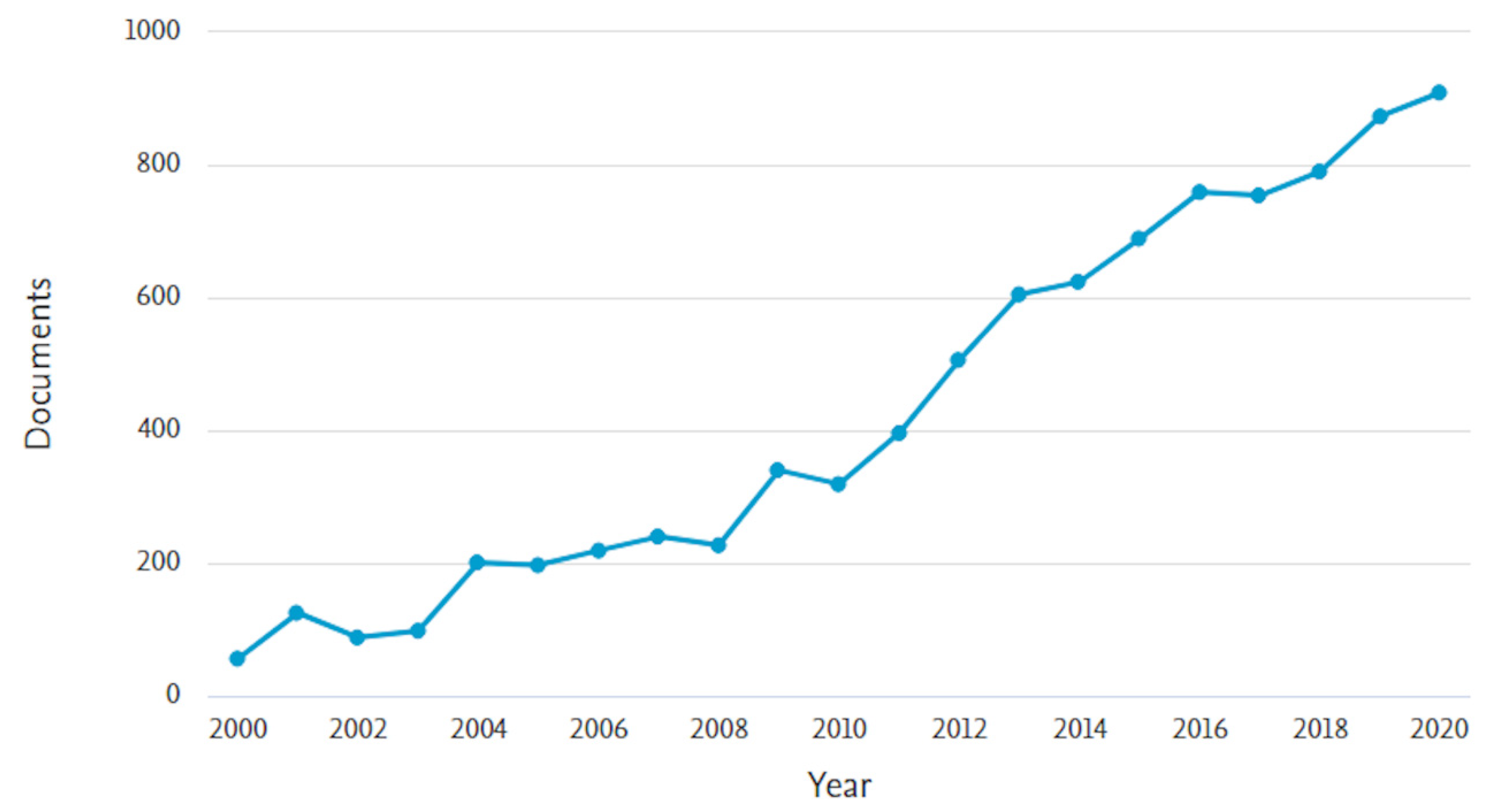
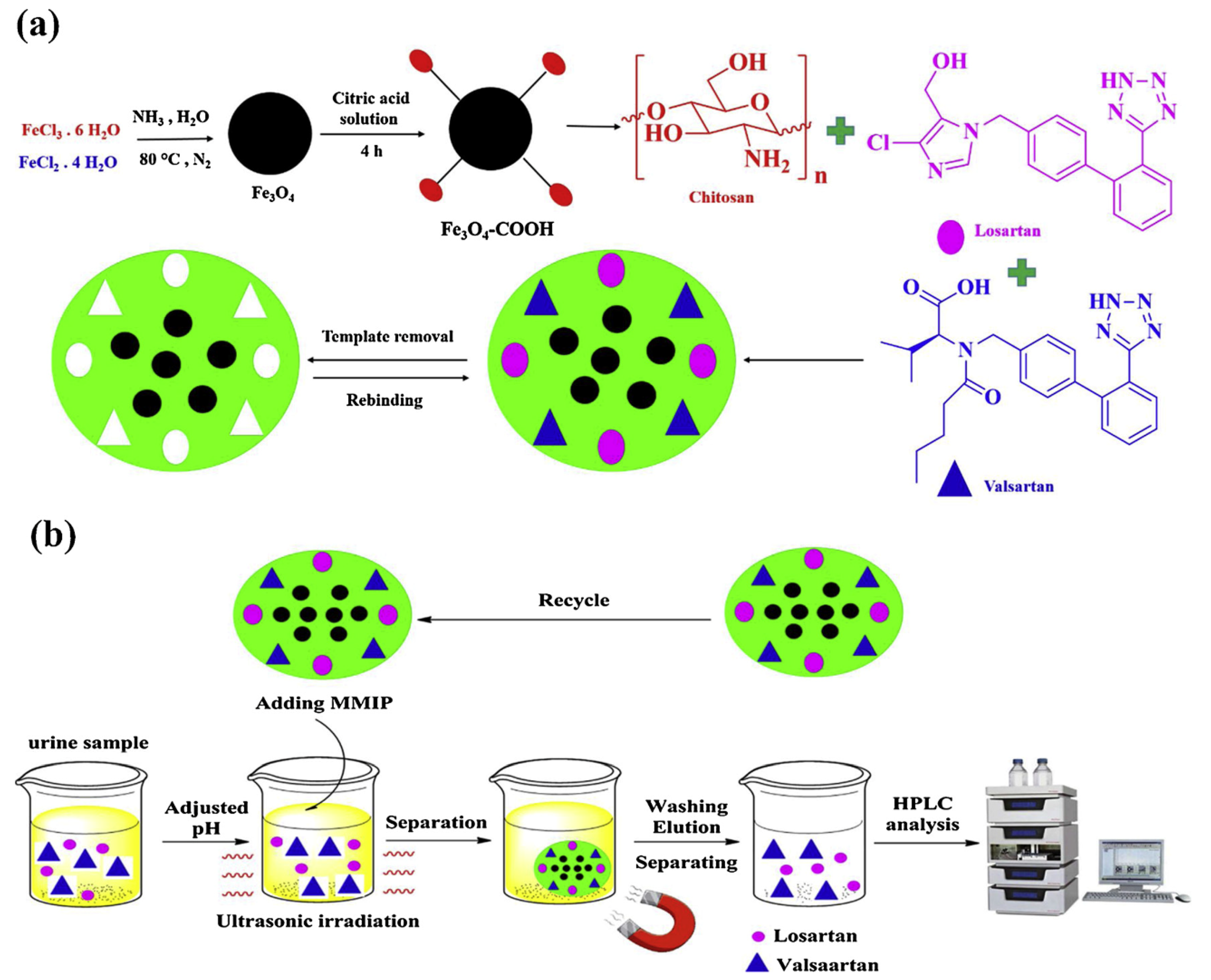

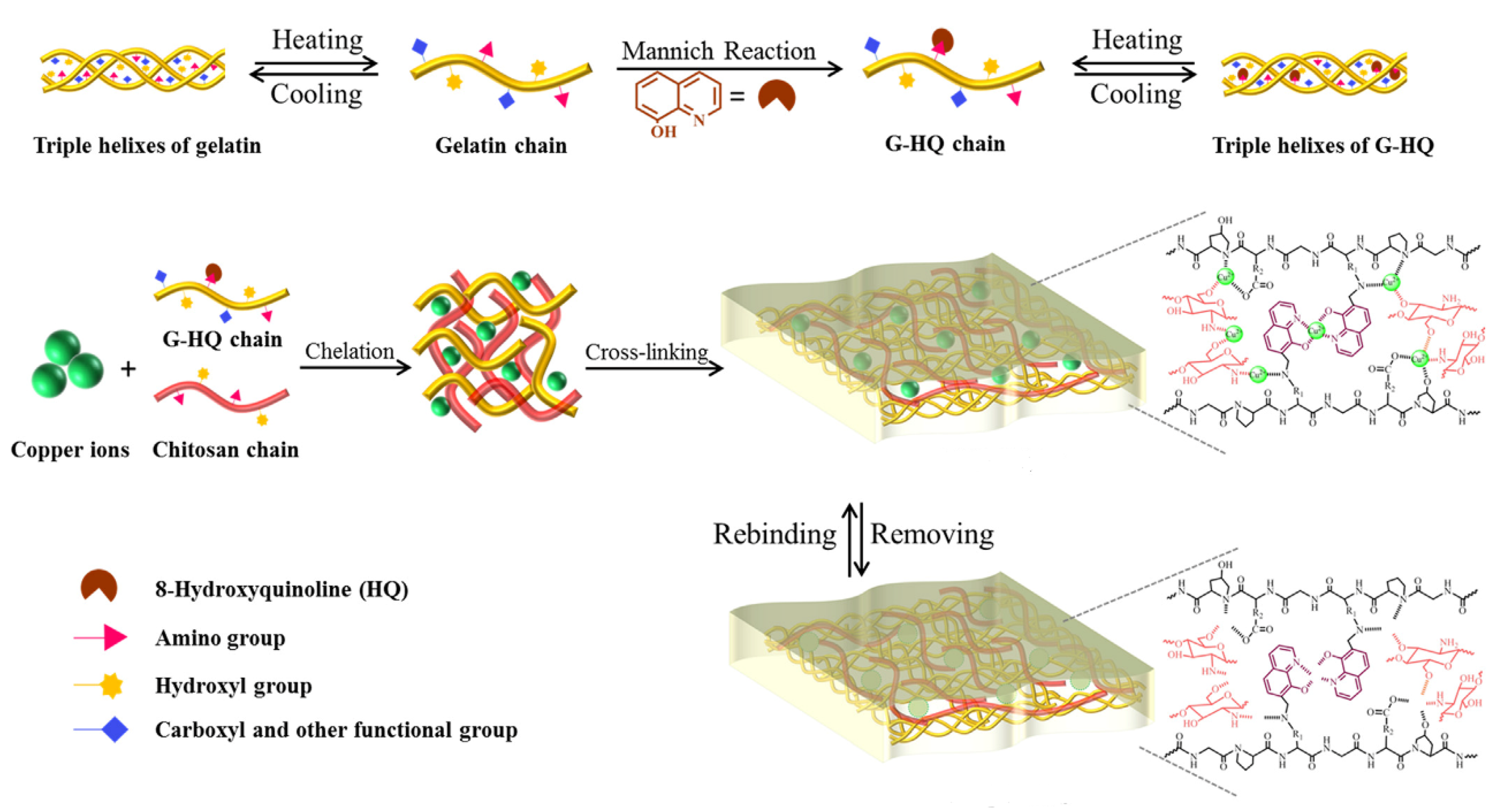


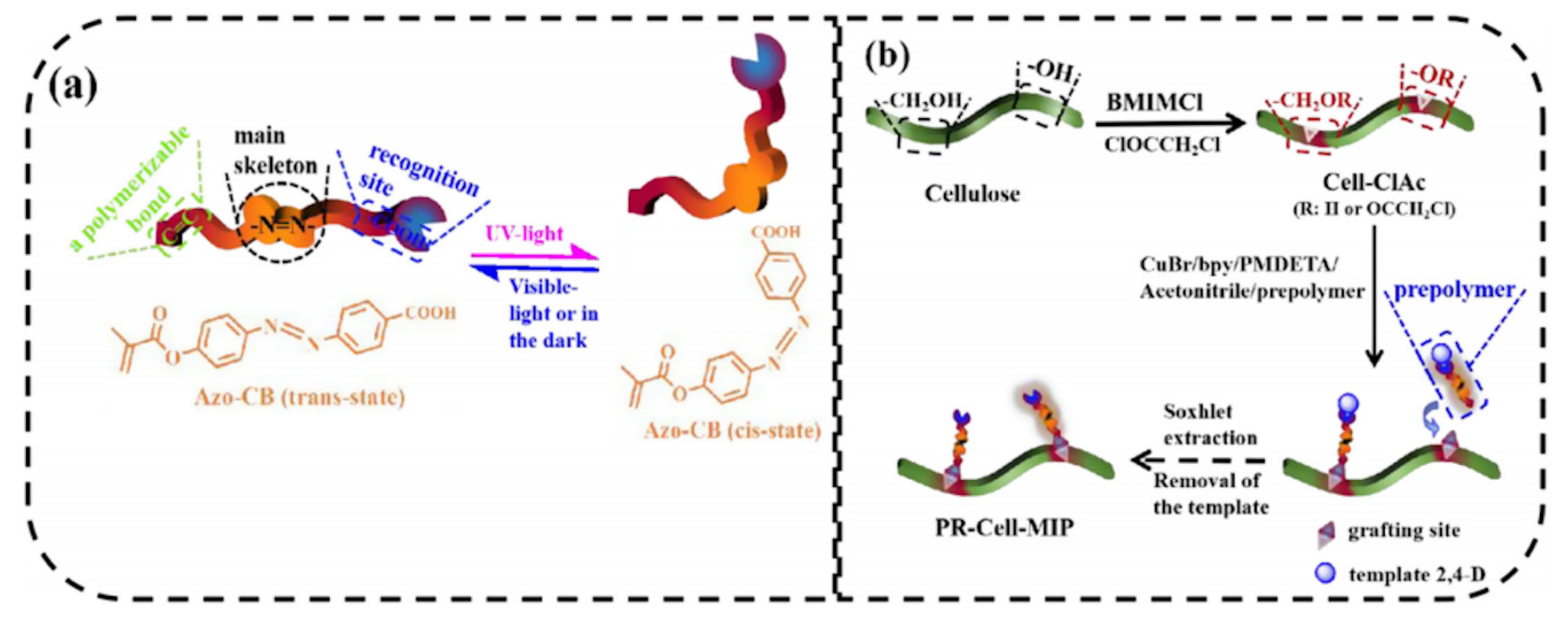
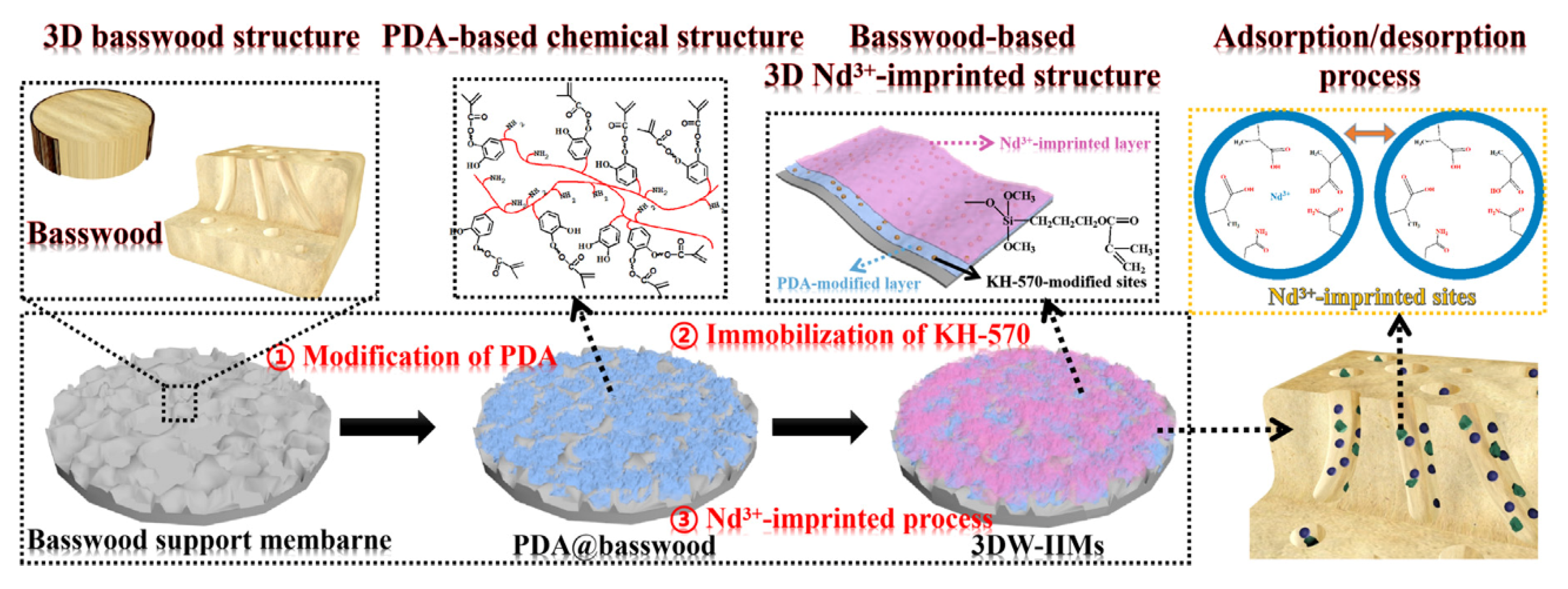
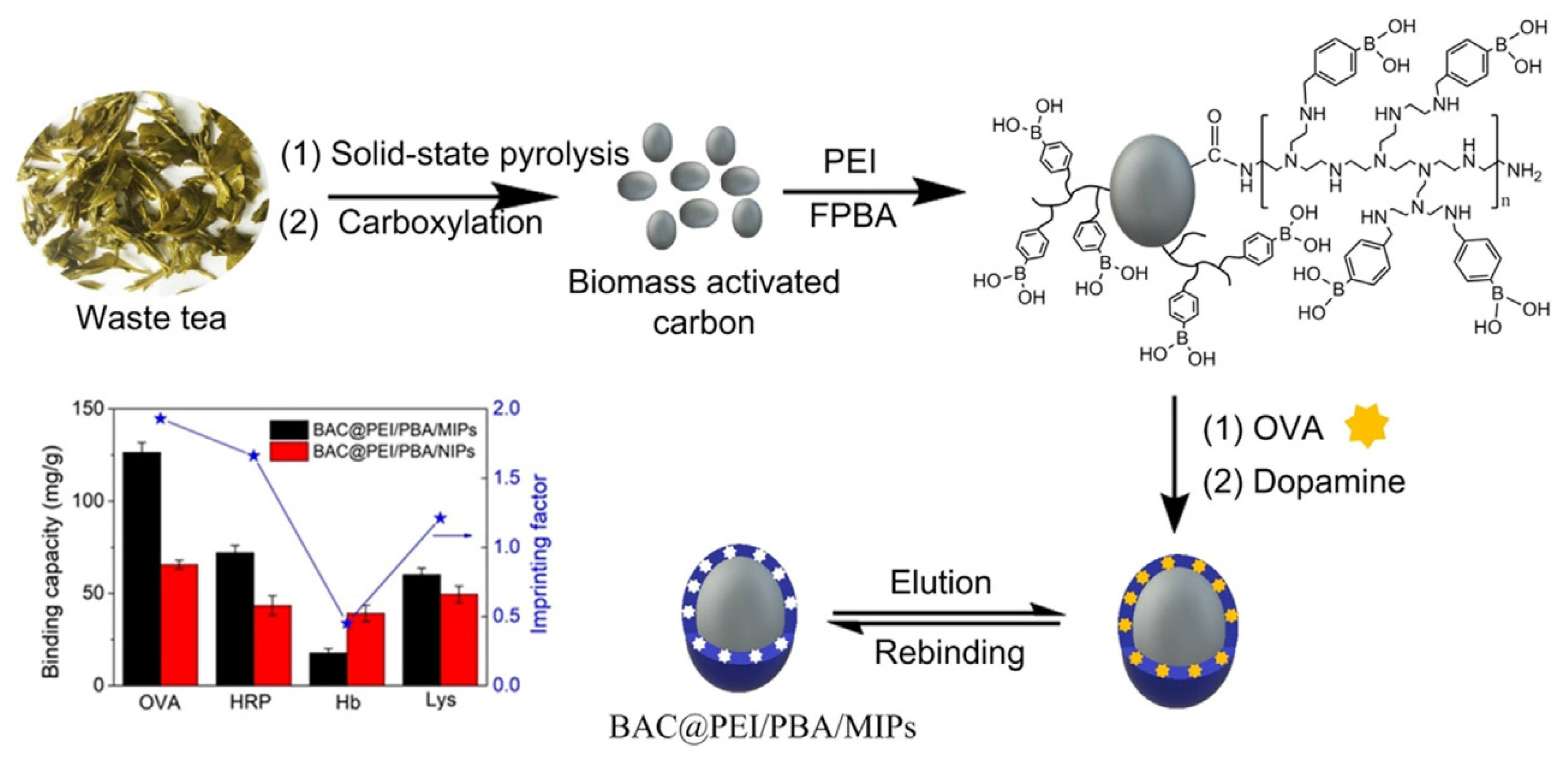


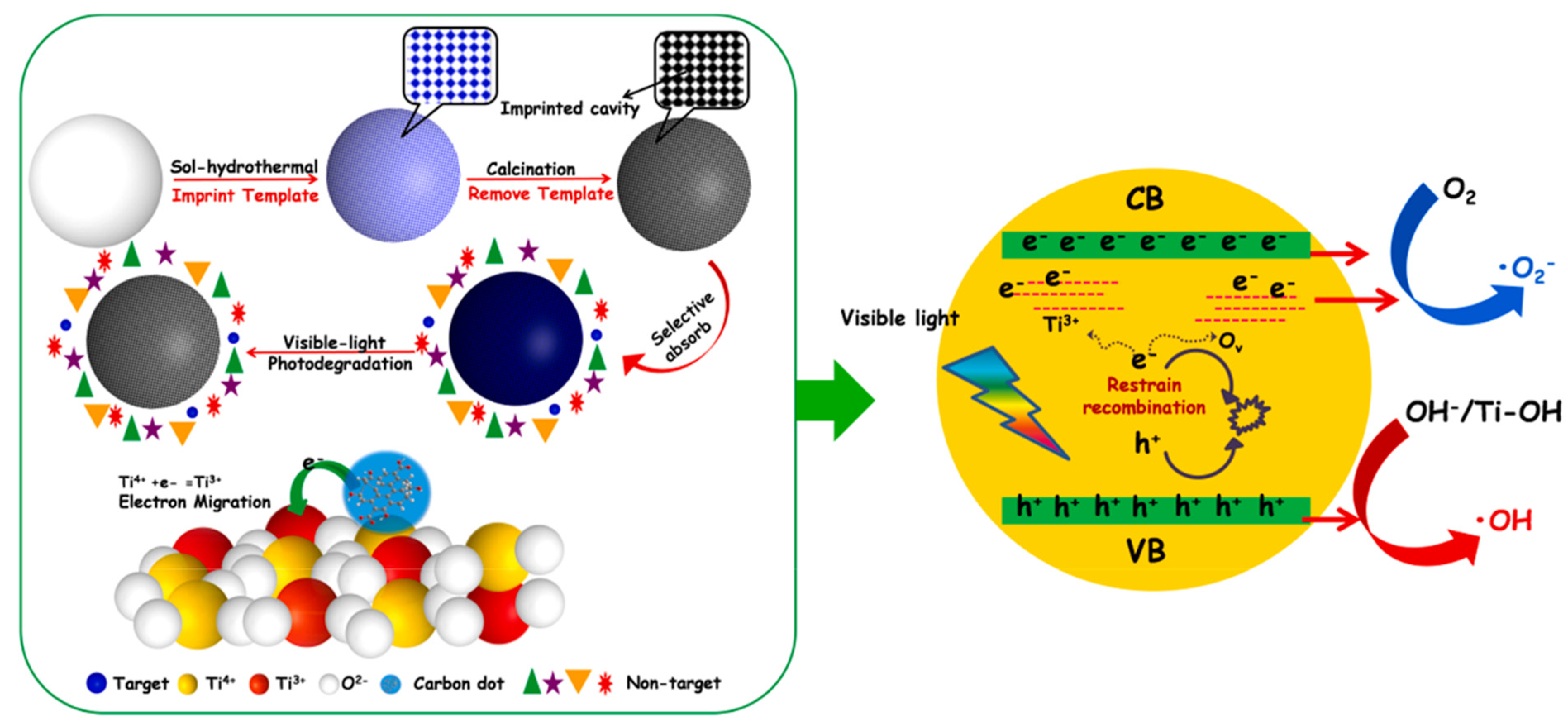
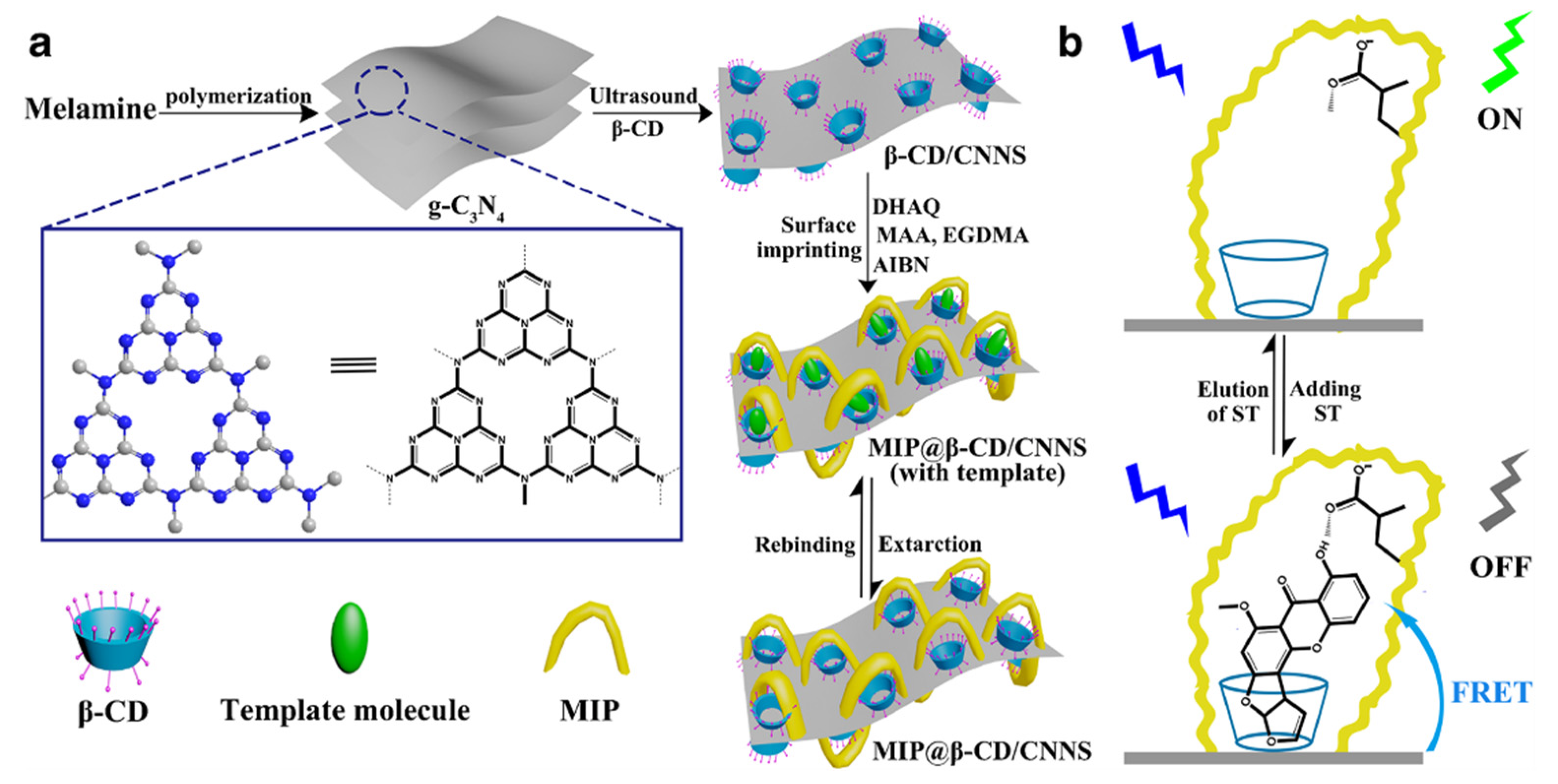
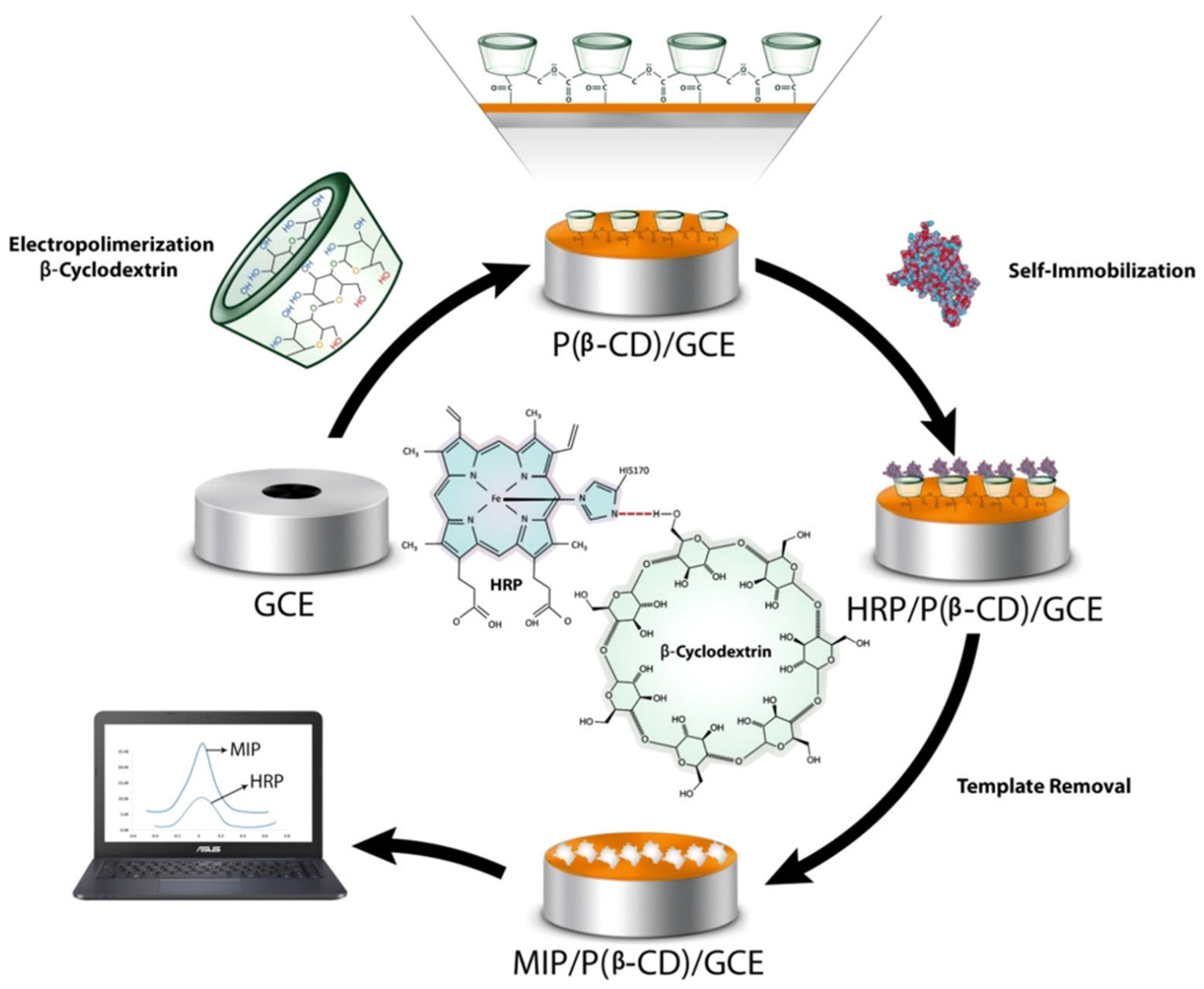
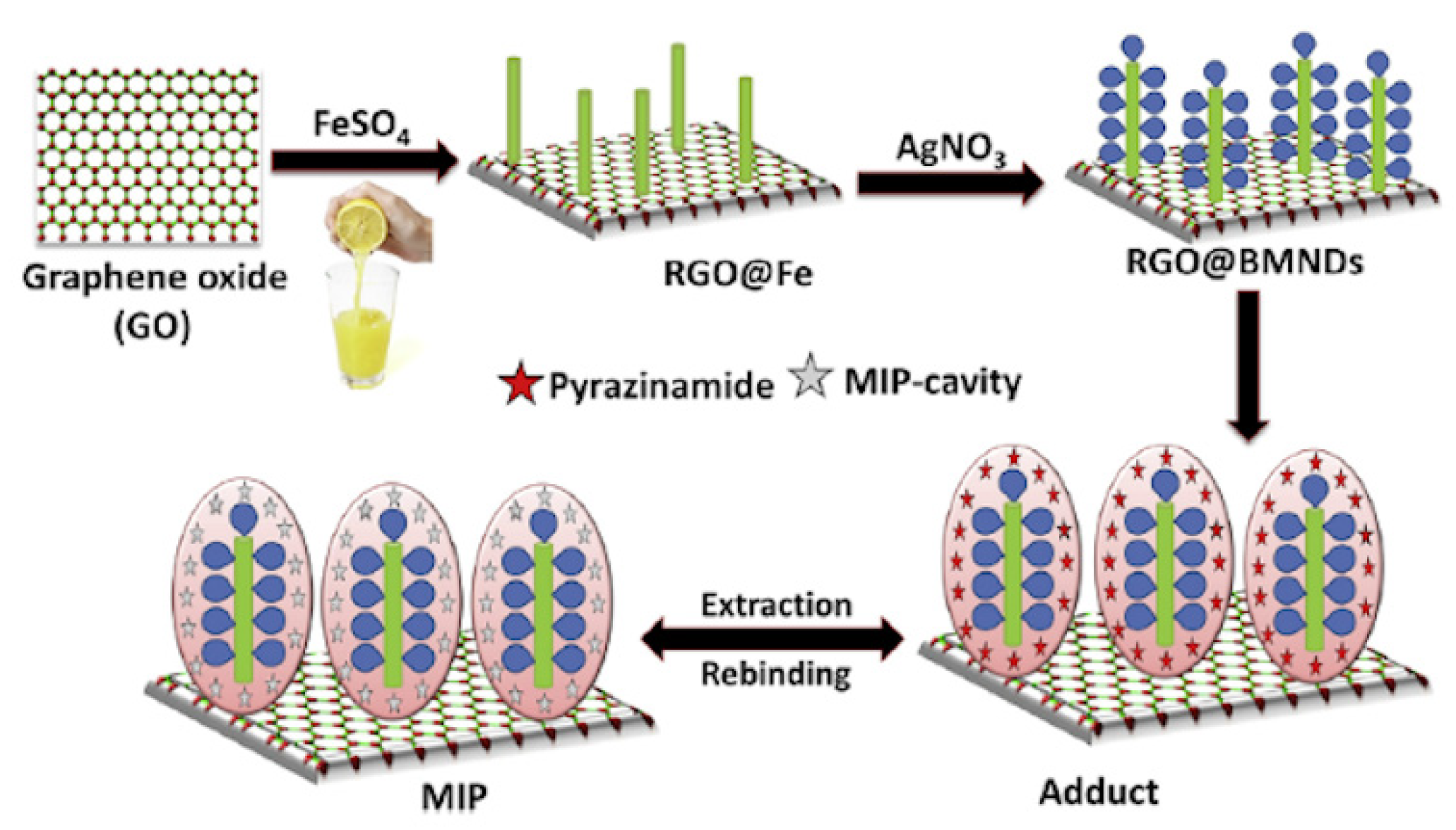
| Waste Material | MIP Composition | MIP Strategy | Target Analyte | Application | Ref. |
|---|---|---|---|---|---|
| Chitosan | Core–shell CS-based magnetic MIPs | Surface imprinting | Acrylamide | Clean-up and pre-concentration in biscuit samples | [48] |
| Chitosan | Core–shell CS-based magnetic MIPs | Surface imprinting | Valsartan Losartan | Simultaneous pre-concentration and determination from urine samples | [49] |
| Chitosan | MIP on the surface of magnetic CS/graphene oxide | Surface imprinting | Fluoxetine | Separation and pre-concentration in pharmaceutical formulation, human urine and environmental water sample | [50] |
| Chitosan | Core–shell chitosan gold nanoparticles/decorated MIP | Surface imprinting | Ciprofloxacin antibiotic | Electrochemical biomimetic sensor | [51] |
| Chitosan | IIPs membrane of gelatin/8-hydroxyquinoline/CS | Crosslinking of gelatin, 8-hydroxyquinoline and CS | Cu(II) | Removal from aqueous solution | [52] |
| Chitosan | Ion imprinted CS microspheres | Microfluidic technique | Ca(II) | Removal of Cu(II), Cd(II) and Pb(II) from wastewater | [53] |
| Chitosan | Ion imprinted thiourea modified CS microspheres | Microfluidic technique | Cu(II) | Removal from wastewater | [54] |
| Cellulose | Water compatible CMC/AA/2-hydroxyethylmethacrylate | Crosslinking of CMC, AA, 2-hydroxyethylmethacrylate | Furosemide | Slow release in drug delivery | [70] |
| Cellulose | Polypyrrole/Sulphur-CMC IIPs | Glassy carbon electrode modified by electro-polymerizing of pyrrole and Sulphur-IIPs drop coated | Hg(II) | Electrode modifier for the electrochemical detection of Hg(II) | [77] |
| Cellulose | MIP/CMC coupled with magnetic material | Surface imprinting on magnetic CMC nanocrystals | Fluoroquinolones | Adsorption and determination in water | [56] |
| Cellulose | Photo-responsive cellulose-based imprinted polymer | Surface-initiated atom transfer radical polymerization | 2,4-dichlorophenoxyacetic acid | Photo responsive sorbent material | [73] |
| Cotton wool cellulose | Hierarchical silica-based ion imprinted mesoporous polymers | Via dual template method | Cd(II) and Pb(II) | Micro solid phase simultaneous extraction from river water and fish muscles | [71] |
| Rice straw cellulose | Straw-supported IIPs | Surface imprinting combined with AGET-ATRP | La(III) | Sorbent material | [85] |
| Basswood cellulose | 3D-macroporous wood-based membrane decorated with imprinted domains | Two-step-temperature free radical polymerization | Nd(III) | Sorbent material | [82] |
| Agricultural waste biochar | Activated biochar functionalized with 3-mercaptopropyltrimethoxysilane-based IIPs | Surface imprinting | Cd(II) | Selective removal from wastewater | [91] |
| Waste tea derived carbon | Activated carbon support of dopamine-based imprinted polymer with multi-boronic acid sites | Surface imprinting | Albumin | Selective capture of glycoprotein | [94] |
| Sunflower heads | Activated carbon support of acrylamide-based imprinted polymer | Surface imprinting | CO2 | Selective adsorption in the presence of H2O and in simulated flue gas | [92] |
| Teak ligno-cellulosic material | Activated carbon/MIP/parafin | By mixing paraffin, MIP and activated carbon | Melamine | Electrochemical biosensor | [93] |
| Sweet potato peels | MIP-coated CDs | Sol–gel polymerization | Oxytetracycline | Fluorescence probe for specific recognition and sensitive detection in honey | [105] |
| Longan peels | CDs coupled with restricted access materials and MIPs | Multifunctional composites by a simple polymerization method | Metronidazole | Fluorescence probe for specific recognition and sensitive detection in serum | [107] |
| Mango peels | CDs encapsulated into MIPs | Sol-gel polymerization | Mesotrione | Fluorescent biosensor for detection in corn | [108] |
| Rosemary leaves | CDs embedded in silica MIPs | Reverse microemulsion and surface imprinting | Thiabendazole | Optical probe for quantification in apple, orange, and tomato juices | [109] |
| Starch | MIPs coated CDs | Epitope approach with glucuronic acid | Hyaluronan | Cancer cell biotargeting and bioimaging | [110] |
| Lignite | MIP-TiO2-x/CDs nanocomposite | Two-step hydrothermal calcination method | Methylene blue | Photocatalytic degradation in wastewater | [26] |
| Cyclodextrins | Magnetic MIP of MAA-βCD | Bulk polymerization | Bisphenol A | Magnetic sorbent for pollutant removal from water | [117] |
| Cyclodextrins | β-CD/functionalized carbon nitride nanosheets | Surface imprinting | Sterigmatomycin | Fluorometric detection | [134] |
| Cyclodextrins | β-CD/graphitic carbon nitride composite | β-CD non-covalently functionalized carbon nitride | Platelet derived growth factor BB | Electrochemiluminescent aptasensor | [135] |
| Cyclodextrins | poly ß-CDs on the electrode surface | Electropolymerization | horseradish peroxidase and H2O2 | Electrochemical biosensor in human plasma | [136] |
| Eucalyptus extract | Magnetic MIP-green iron nanoparticles using eucalyptus extract | Surface imprinting | Non-steroid anti-inflammatory drugs | Magnetic sorbent material | [150] |
| Lemon juice | Imprinted reduced graphene oxide@bimetallic nanodendrites | Surface imprinting | Pyrazinamide | Electrochemical sensor | [151] |
| Guava Leaves aqueous extract | Silver imprinted zinc nanoparticles | Plant extracts mediated synthesis | Methylene blue | Photocatalytic water detoxification | [152] |
| Soybean oil | MIP using epoxidized soybean oil as crosslinking agent | Thermal polymerization | Resveratrol | Biopesticide delivery system | [153] |
| Solanum tuberosum starch | Ion imprinted Starch/PVA nanofibers | Electro-spinning | Thorium (IV) | Sorbent material | [154] |
Publisher’s Note: MDPI stays neutral with regard to jurisdictional claims in published maps and institutional affiliations. |
© 2021 by the authors. Licensee MDPI, Basel, Switzerland. This article is an open access article distributed under the terms and conditions of the Creative Commons Attribution (CC BY) license (https://creativecommons.org/licenses/by/4.0/).
Share and Cite
Del Sole, R.; Mele, G.; Bloise, E.; Mergola, L. Green Aspects in Molecularly Imprinted Polymers by Biomass Waste Utilization. Polymers 2021, 13, 2430. https://doi.org/10.3390/polym13152430
Del Sole R, Mele G, Bloise E, Mergola L. Green Aspects in Molecularly Imprinted Polymers by Biomass Waste Utilization. Polymers. 2021; 13(15):2430. https://doi.org/10.3390/polym13152430
Chicago/Turabian StyleDel Sole, Roberta, Giuseppe Mele, Ermelinda Bloise, and Lucia Mergola. 2021. "Green Aspects in Molecularly Imprinted Polymers by Biomass Waste Utilization" Polymers 13, no. 15: 2430. https://doi.org/10.3390/polym13152430
APA StyleDel Sole, R., Mele, G., Bloise, E., & Mergola, L. (2021). Green Aspects in Molecularly Imprinted Polymers by Biomass Waste Utilization. Polymers, 13(15), 2430. https://doi.org/10.3390/polym13152430








